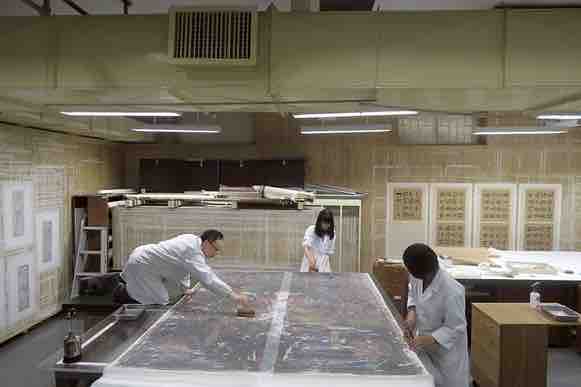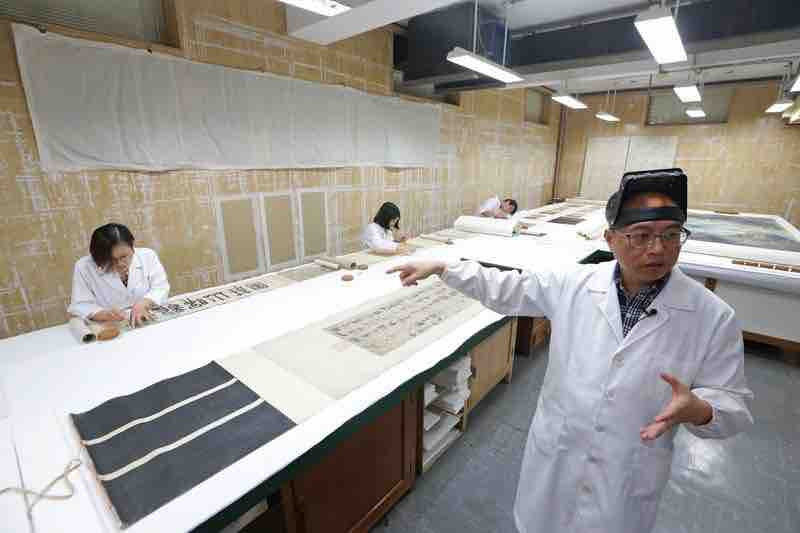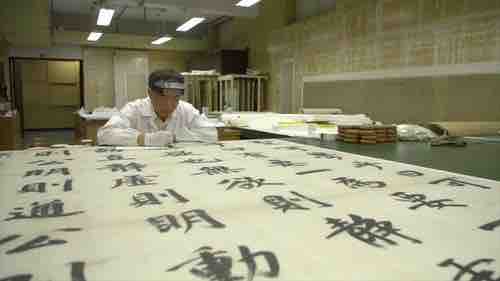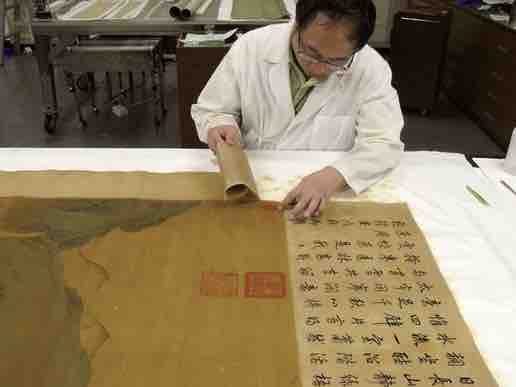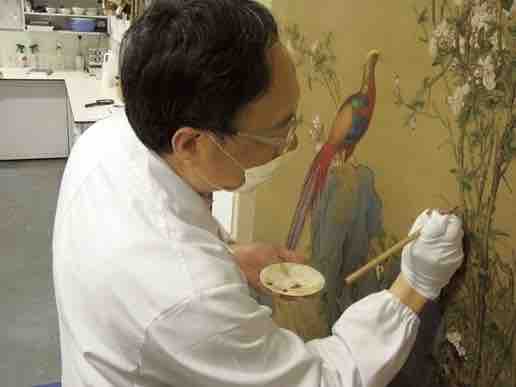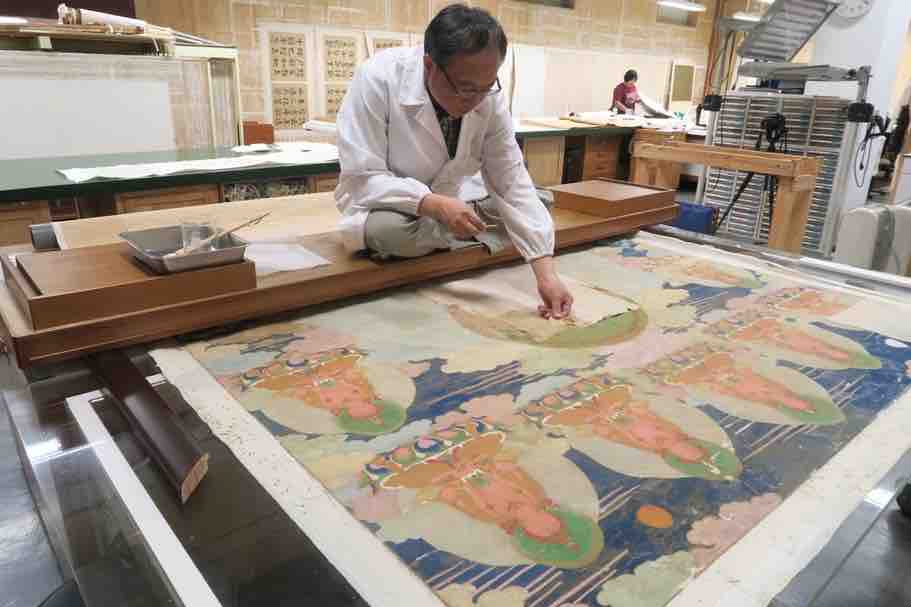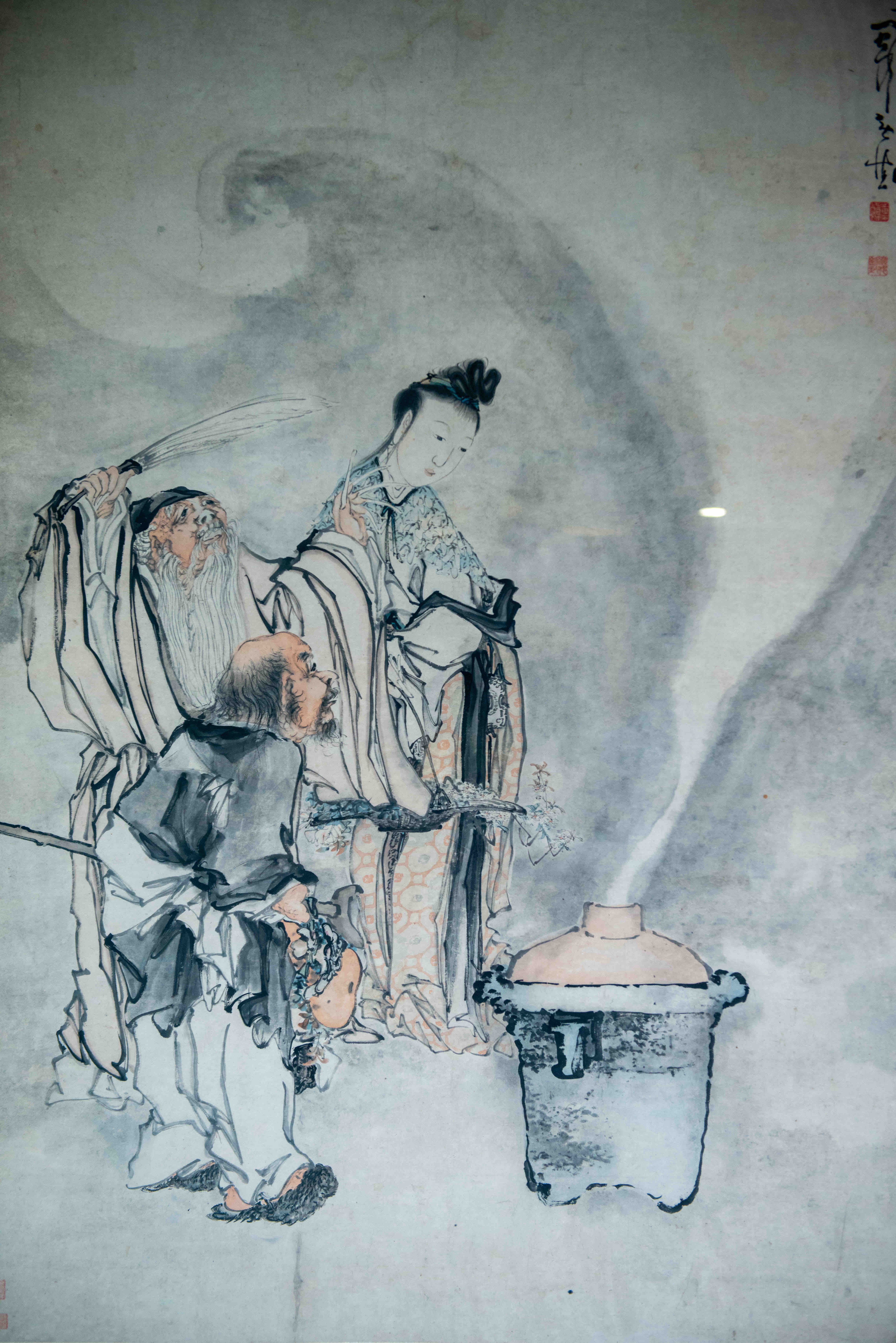Restoration
Painting and calligraphy restoration are a very ancient industry. Similar occupations have existed ever since the invention of paper in the Eastern Han Dynasty, so the restoration process has a history of 1,700 years.
1. Temperature and Humidity Requirements for Different Artifacts
Materials used to construct the artifacts are generally divided into two groups: organic and non-organic. Usually, 90% of the artifacts are made with organic materials. All organic materials are mostly hydrocarbons, and the rest are inorganic materials. Inorganic materials, such as bronze, jade, ceramic, or metals, have different preservation conditions as organic materials.
Artifacts get divided into different categories based on their types, for example, the Chinese painting and calligraphy category, which includes papers and silks. These artifacts would require a humidity of around 55%. The required temperature is also fixed at around 20°C. The restoration area in the National Palace Museum is chilly, and has been fixed at a temperature of 22°C in recent years, with a humidity of 58% percent. Artifacts like calligraphies, artwork, and lacquerware are best kept in this kind of environment.
In addition, artifacts made of metals, like bronze tools, requires a lower humidity level. This is because artifacts constructed with metals are highly sensitive to water, requiring a humidity level of at most 45%.
Moreover, porcelain, pottery, and jade artifacts are basically less sensitive to humidity and temperature. So a restorer wouldn’t need to worry too much about the humidity and temperature, because the artifact isn’t sensitive to those conditions.
2. How to Decide Which Artifacts Need to be Restored
Besides the ones which are going to be exhibited, there are two kinds of artwork that need to be repaired most often, one is calligraphy and painting, the other is books and documents.
These paper artworks were collected by Emperor Qianlong of the Qing Dynasty, as for the paintings and calligraphy may have been painted in Tang, song, yuan, Ming and Qing Dynasties. These paper artworks are already over two hundred years old. All cultural relics have their own life span, in general, they can only last two to three hundred years when they are carefully conserved. Even if they are stored in the cabinet, they will still be affected by humidity, insects, or some files may be stacked in piles which result in deformation. Therefore, those paper artworks need to be repair frequently than other kinds of artifacts.
3. General Restoration Process
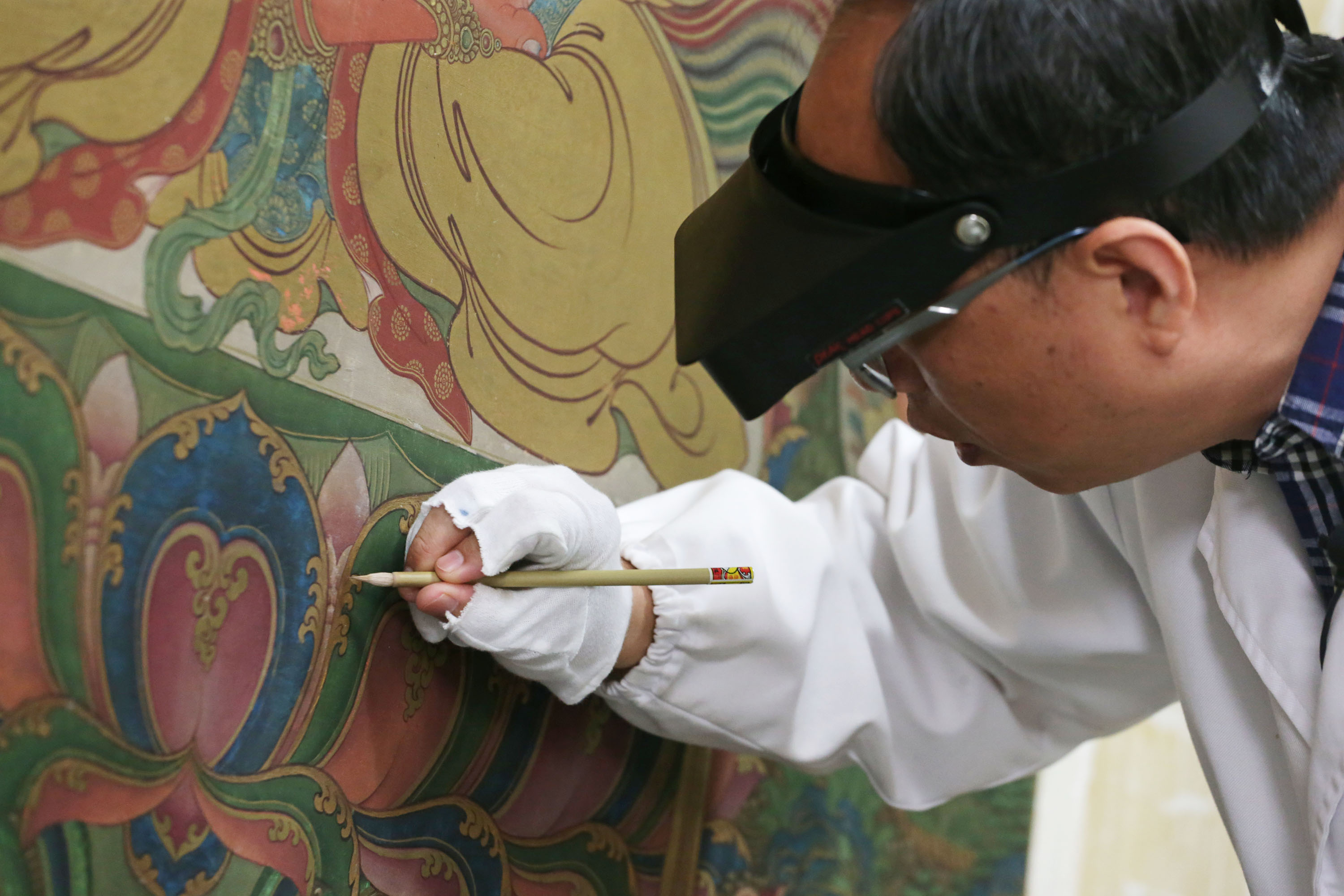 From ancient times to the present, the entire restoration work has no fixed methods or fixed
materials.
In ancient times, the materials or methods used did not change as quickly as they are now.
Nowadays, there are increasingly more materials that can be used to fix an art piece.
However, when deciding whether to use a certain material, some rigorous experiments must be
conducted.
From ancient times to the present, the entire restoration work has no fixed methods or fixed
materials.
In ancient times, the materials or methods used did not change as quickly as they are now.
Nowadays, there are increasingly more materials that can be used to fix an art piece.
However, when deciding whether to use a certain material, some rigorous experiments must be
conducted.
Damaged cultural relics are like ill patients. A good doctor shouldn’t treat every patient in the same way, instead, he or she supposed to consider different physical conditions and make adjustments accordingly. Same rule applies to cultural relic restoration.
However, there is still a standard procedure. Normally repairing a painting requires at least twenty to thirty basic steps. Sometimes a restorer will repeat the same step several times in order to get the best result, and the other times a few steps will be skipped due to the condition.
The material used in the painting is also a factor. If the materials used for each painting are different, that will lead to different repairing process. For example, techniques used inn silk painting and paper painting are different. Sometimes size also affects.
The following table shows the general restoring process.
| Before restoring | During restoring | After restoring |
|---|---|---|
|
1.Examining artifacts, both visually and using scientific tools, like the X ray, infrared projecting,
etc. 2.Maintaining full conservation records by documenting the condition of an object or site, including any previous restoration work and to outline treatment methods and materials in detail. 3.Documentation ensures the careful recording of treatment procedures and materials so there can be no misunderstanding in the future about what is part of the original work of art and what has been added or altered by the conservator. 4.Going through an apprenticeship and get qualification/certification to learn the latest conservation skills. 5.Producing a visual record of the object for identification purposes and to illustrate its
condition. 6. Presenting a proposal for work to be done as well as a report on the completion of the treatment. 7.Knowing the background of the project they will conserve/restore. 8.Observing things/parts of the project that need repairing. 9. Discussing with the director or partners of the artwork. 10. Planning fixing schedule and sequence. |
1.Recording objects with written reports and photos to facilitate repair suggestions and actual handling inspections. 2.Monitoring and recording display and storage conditions with the aim of keeping objects in a stable condition. 3.Calculate the cost of the conservation. 4.Restorer gives advice and a progress report on the conservation job. 5.Restoration to bring a deteriorated or damaged object or structure closer to a previous or assumed appearance. 6.Might have to improvise to restore the artwork. 7. Patching up holes, cleaning off old varnish, and retouching to focus on stabilizing the artwork and
preventing any further degradation. |
1.The project director organizes and gives each restorer a task in the project, helping and directing them along the way. 2.Developing and maintaining appropriate standards within the specialist area. 3.Ensuring the preservation of any collection in order to create a safe display and storage environment that will not cause further deterioration of the objects. 4.Maintaining the integrity of each work of art throughout its life, whenever it is handled, stored, displayed, or shipped to other locations for exhibitions. 5.Recommending preservation procedures, such as control of temperature and humidity, to curatorial and building staff. 6. Advising on procedures for the safety exhibition and travel of cultural materials 7. Keeping up to date with the latest restoration techniques and practices through research and training. 8.The examination of the object, treatment proposal, and the actual treatment is documented with written reports and photographs. 9.Exhibiting the artwork. |
4. Ways to Deal with Incidents
Incidents do happen some times, and how to deal with those various from case to case. In general, the ways to deal with lent out and borrowed art pieces are different. Two cases and the solutions are shown in the following paragraphs.
Once, the British Museum sent some artifacts over to the National Palace Museum for exhibition. When restorers unboxed the artifact, they found it damaged. In scenarios like this, both sides need to discuss and come up with the best possible solution to restore the artifact. Because the artifact belonged to the British Museum, it involves many problems, such as insurance and responsibility. If the other side entrusts the National Palace Museum to restore it, we must do it perfectly. If the other side does not agree with the National Palace Museum to assist in restoration, then this artifact will not be displayed.
Another incident happened when artifacts from the National Palace Museum were sent to the Art Gallery of New South Wales. Even if the artifacts were inspected before going abroad, damages still occurred during the transportation. If it’s a minor problem, NPM can choose to have it repaired locally and displayed after restoration is completed.
When facing emergencies, there are specific procedures, but improvisation and an understanding of artifacts are necessary. All of these need to rely on accumulated experiences in order to respond to the situation immediately.


5. Ways to Inspect Minor Damages
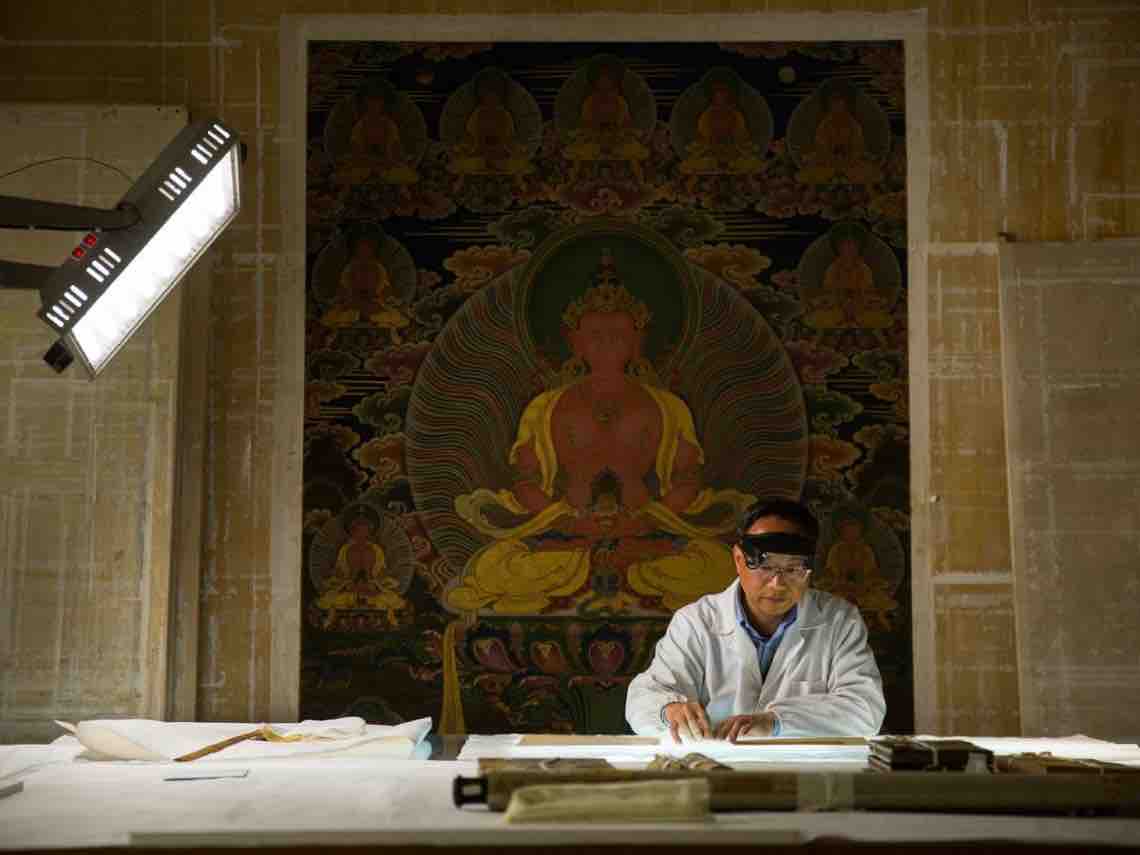 The most basic ability of restorers is the knowledge of artifacts.
A restorer should have the ability to observe the serious changes of an artifact, such as dirt, water
stains, creases, cracks, or breaks through the naked eye at first glance.
However, the restorer often requires the assistance of some tools or instruments because our visual
sensitivity sometimes is not good enough to spot small damages.
The most basic ability of restorers is the knowledge of artifacts.
A restorer should have the ability to observe the serious changes of an artifact, such as dirt, water
stains, creases, cracks, or breaks through the naked eye at first glance.
However, the restorer often requires the assistance of some tools or instruments because our visual
sensitivity sometimes is not good enough to spot small damages.
First, the changes in lighting helps. Restorers turn off the front of the lights and use phones to light up from the side, which is called side light. Through side light, restorers can see the artifacts with a three-dimensional effect, which in turn allows us to see more details of the artifacts.
Another way is to use the "transparent" method, shining the light from the bottom and observing it from the top. By observing the artifacts from different points of view, we can sometimes spot micro damages.
The above inspection is through visible lights. Sometimes, restorers use invisible lights such as ultraviolet or infrared lights. Through those special lights, one can inspect the damage that is invisible through the naked eyes. However, most of the time, one can determine what that needs to be repaired through the use of visible light.
6. Conservation and Restoration
Since a lot of people get confused about conservation and restoration, below are the similarities and differences between them.
| Conservation | Restoration |
|---|---|
| Differences | |
|
1.The conservation of cultural relics is usually performed by professionals with advanced training. 2. Repair damaged or intact artworks 3.Proactive. 4.Conservation is a profession dedicated to the preservation of cultural property for the future. 5.Focus on stabilizing the artifacts also the maintenance and preservation of works of art and their protection from future damage and deterioration. 6.Stabilization refers to treatment procedures intended to maintain the integrity and original material of an object and to minimize deterioration. 7. A manner of care or treatment that repairs damage and also takes action to prevent or slow down further deterioration of an object. 8. Concerned with the long-term preservation of an artwork. 9.Conservation is the profession devoted to the preservation of cultural property for the future. Conservation activities include examination, documentation, treatment, and preventive care. 10.Conservation focuses on the stabilization and preservation of an object using preventative measures to inhibit on-going or future deterioration of the object or its components. 11. Conservation of art and cultural property is an interdisciplinary approach which incorporates art, historic research, scientific analysis, and material science to document, stabilize, and preserve historic artifacts. 12. Be visionary and takes measures to keep the object as it is in its current state. 13. Ensures the objects in a museum's collection are kept in the best possible condition, as well as to serve the museum's mission to bring art before the public. |
1.Art Restoration is often performed by someone who has apprenticed under an artist, trained as an artisan, or simply learned through experience 2. Repair damaged artworks. 3.Passive. 4.Focus on repairing the piece so that it looks as similar as possible to the original artist’s intention. 5. A manner of care or treatment in which the goal is to bring an object back to its original appearance or function. 6.Restoration refers to treatment procedures intended to return objects to a known or assumed state, often through the addition of non-original material such as the replacement of missing ornament. 7. Restoration as traditionally practiced, focuses its efforts upon returning an object or work of art to the object’s original state, an assumed condition, or an earlier appearance. 8. Rather than being concerned with the long-term preservation of an artwork, a restorer focuses on returning an object to its original aesthetic by whatever means necessary. 9.An object to its original state often erases the physical historic markers of an object's use by significantly altering physical evidence and original materials. |
| Similarities | |
|
1. They all try to keep and display the artifacts in a good condition. 2. They returned the artwork to a more improved state. 3.A knowledge of the whole life of artworks brings an essential understanding of its features and its problems. 4. The first requisite in conserving any artworks is a sensitive assessment of its history and merits. 5.The techniques and methods of art conservation and restoration go hand in hand and became the province of trained professionals in the 20th century. 6. The repair or renovation of artworks that have already sustained injury or decay and the attempted restoration of such objects to something approaching their original undamaged appearance. 7. Taking a look back in time to determine how an object would appear in its original time period. |
|
